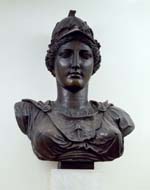Art & Artifacts
Discover the Library Company's Art and Artifact Collection
Distinguished Sculptors
Giuseppe Ceracchi
The son of a goldsmith, Giuseppe Ceracchi (1751-1802) was an Italian neoclassical sculptor who became known in America for his likenesses of Revolutionary War heroes. After studying in Rome and at the Academia di San Luca, he traveled to London in 1773 where he modeled architectural sculpture for buildings, such as the Somerset House. In 1790 and again in 1794, Ceracchi ventured to America, in hopes of garnering an extensive Congressional commission. Though the project fell through due to insufficient funds, he sculpted thirty-six prominent Americans in his process of campaigning Congress. One such portrait was a bust of George Washington, the only likeness that the President saw himself and the only one to sit in his home in Philadelphia. Disillusioned with his failed American plan, Ceracchi returned to Italy in 1794 and eventually moved to France in 1799. He quickly became embroiled in anti-Napoleon riots and was executed in 1802.
Giuseppe Ceracchi (1751-1802).
Minerva as Patroness of American Liberty, ca. 1791-1792.
Terra cotta.
Library Company of Philadelphia. Gift of Continental Congress, ca. 1800.
Giuseppe Ceracchi, Minerva as Patroness of American Liberty
As a means of promoting his American commission for a colossal equestrian statue of Washington, Ceracchi crafted this five and a half foot, bronze-painted terra cotta sculpture. The bust epitomizes his neoclassical style, depicting liberty as Minerva, adorned in full Roman armor. Presented to the first Congress, the piece stood behind the speaker’s chair in the House of Representatives in Congress Hall. The bust, like Ceracchi, fell out of favor; at some point it was moved to a water closet, before it was presented to the Library Company when Congress moved to Washington.
